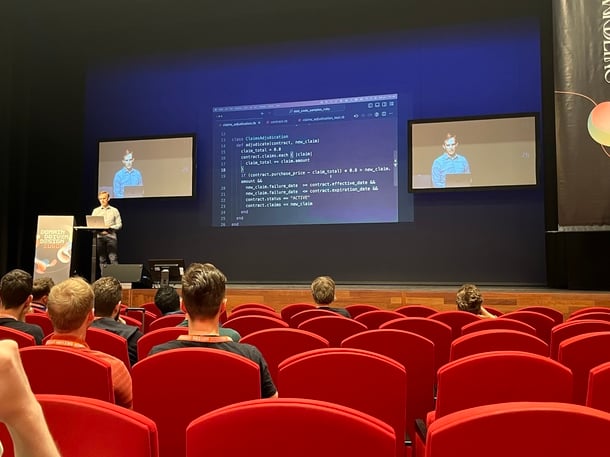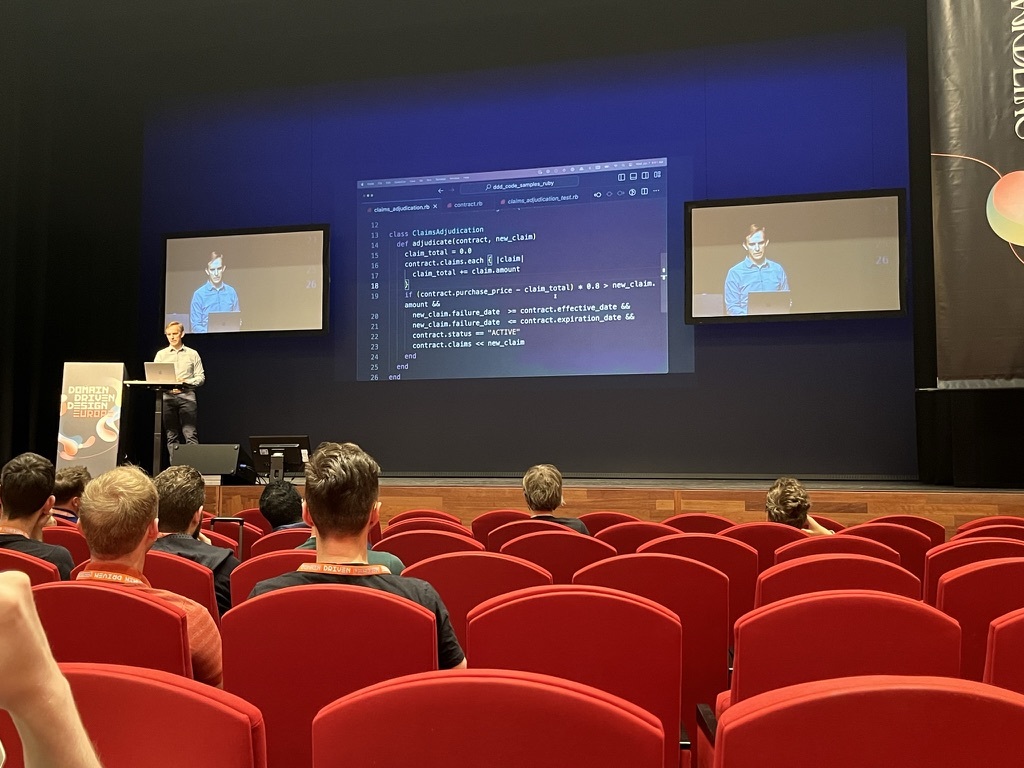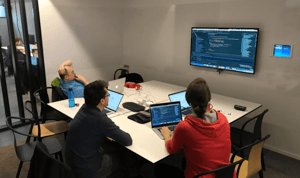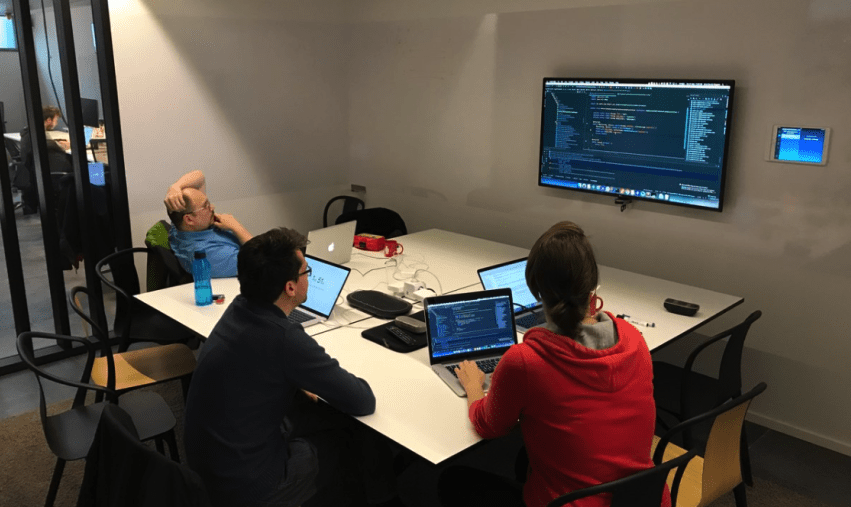

In June 2023, four ACA colleagues participated in the Foundations Day of the multi-day event of Domain-Driven Design Europe (DDD Europe). At the Meervaart theater in Amsterdam, they attended various talks offering a practical perspective on DDD concepts. The complete report is provided below.
Following a refreshing coffee for the early birds and the welcoming remarks by the organizers, a packed program of eight talks with live coding ensued.
This blog post offers a concise overview of all presentations, followed by an evaluation across different areas: speaker inspiration, relevance to Domain-Driven Design (DDD), utilized analysis techniques, and technical usability of the information.

Reviews
Baking Domain Concepts into Code
This session was led by Paul Rayner, an Australian residing in the United States. He delivered a structured and engaging session with fresh insights into Domain-Driven Design and coding, showcasing a strong preference for Test-Driven Design. He delved into the concept of extended warranties, demonstrating it step by step in Ruby code using Event Storming.
As his narrative progressed and complexity increased, he adeptly addressed questions arising from the Event Storming with a Test-Driven approach. His concluding message was clear: "Don't be afraid to refactor code when starting from a fundamental Test-Driven method!"
Even for those with limited knowledge of DDD, the logic in his reasoning during the live coding was easy to follow. Although he isn't scheduled as a speaker for the upcoming edition of DDD Europe, if you ever have the chance to attend a session by Paul Rayner, don't hesitate: it's highly recommended.
Score card (1-5):
- Inspiration: 3
- Relevance to DDD: 5
- Analysis techniques: 4
- Technical usability: 4
Model Mitosis: A Dynamic Pattern to Deal with Model Tension
This entertaining session was delivered by Julien Topçu and Josian Chevalier. They presented a session within the context of the Mandalorian from the Star Wars saga, demonstrating several typical pitfalls in a development process. It was a fully scripted session where the live coding was supposedly done by an AI named Chat3PO. However, they did employ some interesting concepts such as a Shared Kernel and an Anti-Corruption Layer.
Since it was a scripted session, little time was wasted on writing code. This allowed them to easily switch to domain overviews, keeping the story coherent.
This session is definitely worth recommending because it elucidates an interesting evolution within a domain. In the last five minutes, they also provided a good summary of the evolution they underwent in their scenario and referred to the Hive Pattern where further development of this concept is utilized.
Score card (1-5):
- Inspiration: 5
- Relevance to DDD: 4
- Analysis techniques: 4
- Technical usability: 3
TDD & DDD from the Ground Up - Chris Simon
During the session "TDD & DDD from the Ground Up", several principles of Domain-Driven Design (DDD) were highlighted through a live coding example of Test-Driven Development (TDD). The experienced speaker, Chris Simon, shared his extensive knowledge on this topic. Thanks to his thorough preparation, profound understanding of the subject, and pleasant pace, this session was suitable for an audience of developers and analysts looking to explore the basic principles of TDD.
While the TDD portion was well-executed, there was a lack of a clear connection with DDD. Consequently, the session felt more like a TDD demo, with only limited attention to DDD principles. Additionally, the viewing experience was negatively affected by the low quality of the projected code, combined with the presence of ample sunlight in the room.
For those seeking to establish a solid foundation in Test-Driven Development, this session was certainly recommended. However, if you're more interested in Domain-Driven Design, there are better sessions available that offer more depth.
Score card (1-5):
- Inspiration: 4
- Relevance to DDD: 2
- Analysis techniques: 1
- Technical usability: 4
The Escher School of Fish: Modelling with Functions
During "The Escher School of Fish: Modeling with Functions", Einar Høst demonstrated the concept of function modeling through live coding in the functional programming language Elm. The example showcased numerous vector transformations to achieve image manipulation.
The presentation certainly appealed to developers. It was fascinating to witness the impressive results that can be achieved through relatively simple vector transformations. However, for analysts, the session likely offered less immediate value. Since the presentation was highly technical, we missed a clear link to Domain-Driven Design.
Despite the visually stunning results, the session seemed to stray from the context of a DDD conference.
Score card (1-5):
- Inspiration: 2
- Relevance to DDD: 1
- Analysis techniques: 1
- Technical usability: 3
TDD: Beyond the Intro Part One & Two
The two-part talk "TDD: Beyond the Intro" by Romeu Moura suggested a deeper dive into Test-Driven Development, and that's exactly what we got. Moura started with the basics of TDD but quickly went beyond the "red-green-refactor" cycle. He viewed TDD as a Socratic dialogue, a method of reasoning using tests as "field notes." His narrative was profound and clear, although the pace was a bit slow at times, making it challenging to stay fully engaged.
Despite the DDD context of the conference, Moura paid little to no attention to Domain-Driven Design. The focus was more on the general principles of TDD and how they can be applied in practice. The talk also included a live coding segment, where Moura built a simple fizzbuzz application using TDD. While this was a useful illustration of the discussed principles, it wasn't necessarily essential to understanding the talk.
Overall, this was a valuable talk for individuals with a technical background seeking to learn more about TDD: in-depth, clear, and practically applicable. Despite the limited references to DDD, it didn't diminish the quality of the presentation.
🎥 Link to the video (Part One)
🎥 Link to the video (Part Two)
Score card (1-5):
- Inspiration: 4
- Relevance to DDD: 1
- Analysis techniques: 1
- Technical usability: 4
Refactoring to a really small but useful model island
The speaker of this session, Yves Lorphelin, is an experienced software engineer with a passion for Domain-Driven Design. He shared his enthusiasm and expertise in an inspiring manner. The talk was clear and well-structured, with concrete examples and illustrations. Lorphelin addressed audience questions with knowledge and humor.
The talk was clearly rooted in the principles of Domain-Driven Design. Lorphelin demonstrated how refactoring towards a small model island can help reduce the complexity of a software project and better organize the code around core domain models.
Lorphelin discussed several analysis techniques that can be used to identify core domain models. These techniques include:
- Bounded context analysis: Identifying areas of the application with their own domain logic.
- Ubiquitous language: Developing a common language shared by all stakeholders.
- Event storming: Modeling domain logic through events.
The talk was aimed at software developers and architects with a basic knowledge of Domain-Driven Design. Lorphelin delved into the technical details of refactoring towards a small model island, but he also maintained an abstract level to keep the talk accessible to a broad audience.
Score card (1-5):
- Inspiration: 3
- Relevance to DDD: 3
- Analysis techniques: 4
- Technical usability: 3
Living in your own bubble - Jacob Duijzer: From legacy to Domain Driven Design
In this session, agile coach Jacob Duijzer explained how he tackled Legacy code for a project within the agriculture domain. He provided deeper insights into the domain using the Domain Storytelling technique. He outlined the new guidelines applicable to the existing system, which not only was complex and outdated but also lacked documentation, unit tests, and experienced domain experts.
Jacob Duijzer demonstrated how he had domain experts explain the domain using examples (known as 'specification by example'). Following this, he explained 'the bubble context' and how it can be utilized to implement new business rules without impacting the existing system. Finally, he outlined the pros and cons of a bubble context.
Score card (1-5):
- Inspiration: 3
- Relevance to DDD: 5
- Analysis techniques: 4
- Technical usability: 3
Functional Domain Modelling - Marco Emrich and Ferdinand Ade
This presentation brought a touch of theater to DDD 2023, starring Marco (as the developer) and Ferdi (as the customer/Product Owner). The story unfolded as follows…
Ferdi, active in the wine sector, wanted to build an application to recommend the best wine to his customers, tailored to their tastes. It was delightful to see Ferdi thinking aloud about his expectations. Marco immediately tried to translate this into code using 'types'. As Ferdi described step by step how a 'tasting' unfolds, Marco immediately coded it in Ferdi's language. For example, Marco initially chose the term 'wine selection', only to later change it to 'wine cellar'. After all, Ferdi kept referring to their wine cellar, not their selection.
Ferdi continuously looked over Marco's shoulder. Together, they added, removed, and renamed elements. Anything unclear was postponed. Gradually, a shared language emerged between the developer and the customer.
From this entertaining session, we learned that it's beneficial to model together with the customer using event storming or domain storytelling, although the outcome may be abstract. 'Functional Domain Modeling' can be the icing on the cake. The result is explicit, specific, and provides a solid starting point for implementation.
Score card (1-5):
- Inspiration: 3
- Relevance to DDD: 3
- Analysis techniques: 4
- Technical usability: 3
Conclusion
After attending the Foundations Day of DDD Europe 2023, our four colleagues returned home with a wealth of new insights that they will apply in practice.
The theme of live coding provided developers with an excellent opportunity to gain deeper insights into DDD principles. Additionally, many related techniques were covered, such as Test-Driven Development.
Not every session had a clear link to DDD, which was a bit of a drawback for analysts. Nevertheless, the atmosphere throughout the day was exceptionally positive and inspiring. The Meervaart theater proved to be the perfect setting for attendees to network and exchange experiences before and after the sessions.
We're already looking forward to the next edition of DDD Europe!

What others have also read


In software development, assumptions can have a serious impact and we should always be on the look-out. In this blog post, we talk about how to deal with assumptions when developing software. Imagine…you’ve been driving to a certain place A place you have been driving to every day for the last 5 years, taking the same route, passing the same abandoned street, where you’ve never seen another car. Gradually you start feeling familiar with this route and you assume that as always you will be the only car on this road. But then at a given moment in time, a car pops up right in front of you… there had been a side street all this time, but you had never noticed it, or maybe forgot all about it. You hit the brakes and fortunately come to a stop just in time. Assumption nearly killed you. Fortunately in our job, the assumptions we make are never as hazardous to our lives as the assumptions we make in traffic. Nevertheless, assumptions can have a serious impact and we should always be on the look-out. Imagine… you create websites Your latest client is looking for a new site for his retirement home because his current site is outdated and not that fancy. So you build a Fancy new website based on the assumption that Fancy means : modern design, social features, dynamic content. The site is not the success he had anticipated … strange … you have build exactly what your client wants. But did you build what the visitors of the site want? The average user is between 50 – 65 years old, looking for a new home for their mom and dad. They are not digital natives and may not feel at home surfing on a fancy, dynamic website filled with twitter feeds and social buttons. All they want is to have a good impression of the retirement home and to get reassurance of the fact that they will take good care of their parents. The more experienced you’ll get, the harder you will have to watch out not to make assumptions and to double-check with your client AND the target audience . Another well known peril of experience is “ the curse of knowledge “. Although it sounds like the next Pirates of the Caribbean sequel, the curse of knowledge is a cognitive bias that overpowers almost everyone with expert knowledge in a specific sector. It means better-informed parties find it extremely difficult to think about problems from the perspective of lesser-informed parties. You might wonder why economists don’t always succeed in making the correct stock-exchange predictions. Everyone with some cash to spare can buy shares. You don’t need to be an expert or even understand about economics. And that’s the major reason why economists are often wrong. Because they have expert knowledge, they can’t see past this expertise and have trouble imagining how lesser informed people will react to changes in the market. The same goes for IT. That’s why we always have to keep an eye out, we don’t stop putting ourselves in the shoes of our clients. Gaining insight in their experience and point of view is key in creating the perfect solution for the end user. So how do we tackle assumptions …? I would like to say “Simple” and give you a wonderful oneliner … but as usual … simple is never the correct answer. To manage the urge to switch to auto-pilot and let the Curse of Knowledge kick in, we’ve developed a methodology based on several Agile principles which forces us to involve our end user in every phase of the project, starting when our clients are thinking about a project, but haven’t defined the solution yet. And ending … well actually never. The end user will gain new insights, working with your solution, which may lead to new improvements. In the waterfall methodology at the start of a project an analysis is made upfront by a business analist. Sometimes the user is involved of this upfront analysis, but this is not always the case. Then a conclave of developers create something in solitude and after the white smoke … user acceptance testing (UAT) starts. It must be painful for them to realise after these tests that the product they carefully crafted isn’t the solution the users expected it to be. It’s too late to make vigorous changes without needing much more time and budget. An Agile project methodology will take you a long way. By releasing testable versions every 2 to 3 weeks, users can gradually test functionality and give their feedback during development of the project. This approach will incorporate the user’s insights, gained throughout the project and will guarantee a better match between the needs of the user and the solution you create for their needs. Agile practitioners are advocating ‘continuous deployment’; a practice where newly developed features will be deployed immediately to a production environment instead of in batches every 2 to 3 weeks. This enables us to validate the system (and in essence its assumptions) in the wild, gain valuable feedback from real users, and run targeted experiments to validate which approach works best. Combining our methodology with constant user involvement will make sure you eliminate the worst assumption in IT: we know how the employees do their job and what they need … the peril of experience! Do we always eliminate assumptions? Let me make it a little more complicated: Again… imagine: you’ve been going to the same supermarket for the last 10 years, it’s pretty safe to assume that the cereal is still in the same aisle, even on the same shelf as yesterday. If you would stop assuming where the cereal is … this means you would lose a huge amount of time, browsing through the whole store. Not just once, but over and over again. The same goes for our job. If we would do our job without relying on our experience, we would not be able to make estimations about budget and time. Every estimation is based upon assumptions. The more experienced you are, the more accurate these assumptions will become. But do they lead to good and reliable estimations? Not necessarily… Back to my driving metaphor … We take the same road to work every day. Based upon experience I can estimate it will take me 30 minutes to drive to work. But what if they’ve announced traffic jams on the radio and I haven’t heard the announcement… my estimation will not have been correct. At ACA Group, we use a set of key practices while estimating. First of all, it is a team sport. We never make estimations on our own, and although estimating is serious business, we do it while playing a game: Planning poker. Let me enlighten you; planning poker is based upon the principle that we are better at estimating in group. So we read the story (chunk of functionality) out loud, everybody takes a card (which represent an indication of complexity) and puts them face down on the table. When everybody has chosen a card, they are all flipped at once. If there are different number shown, a discussion starts on the why and how. Assumptions, that form the basis for one’s estimate surface and are discussed and validated. Another estimation round follows, and the process continues till consensus is reached. The end result; a better estimate and a thorough understanding of the assumptions surrounding the estimate. These explicit assumptions are there to be validated by our stakeholders; a great first tool to validate our understanding of the scope.So do we always eliminate assumptions? Well, that would be almost impossible, but making assumptions explicit eliminates a lot of waste. Want to know more about this Agile Estimation? Check out this book by Mike Cohn . Hey! This is a contradiction… So what about these assumptions? Should we try to avoid them? Or should we rely on them? If you assume you know everything … you will never again experience astonishment. As Aristotle already said : “It was their wonder, astonishment, that first led men to philosophize”. Well, a process that validates the assumptions made through well conducted experiments and rapid feedback has proven to yield great results. So in essence, managing your assumptions well, will produce wonderful things. Be aware though that the Curse of Knowledge is lurking around the corner waiting for an unguarded moment to take over. Interested in joining our team? Interested in meeting one of our team members? Interested in joining our team? We are always looking for new motivated professionals to join the ACA team! {% module_block module "widget_3ad3ade5-e860-4db4-8d00-d7df4f7343a4" %}{% module_attribute "buttons" is_json="true" %}{% raw %}[{"appearance":{"link_color":"light","primary_color":"primary","secondary_color":"primary","tertiary_color":"light","tertiary_icon_accent_color":"dark","tertiary_text_color":"dark","variant":"primary"},"content":{"arrow":"right","icon":{"alt":null,"height":null,"loading":"disabled","size_type":null,"src":"","width":null},"tertiary_icon":{"alt":null,"height":null,"loading":"disabled","size_type":null,"src":"","width":null},"text":"View career opportunities"},"target":{"link":{"no_follow":false,"open_in_new_tab":false,"rel":"","sponsored":false,"url":{"content_id":229022099665,"href":"https://25145356.hs-sites-eu1.com/en/jobs","href_with_scheme":null,"type":"CONTENT"},"user_generated_content":false}},"type":"normal"}]{% endraw %}{% end_module_attribute %}{% module_attribute "child_css" is_json="true" %}{% raw %}{}{% endraw %}{% end_module_attribute %}{% module_attribute "css" is_json="true" %}{% raw %}{}{% endraw %}{% end_module_attribute %}{% module_attribute "definition_id" is_json="true" %}{% raw %}null{% endraw %}{% end_module_attribute %}{% module_attribute "field_types" is_json="true" %}{% raw %}{"buttons":"group","styles":"group"}{% endraw %}{% end_module_attribute %}{% module_attribute "isJsModule" is_json="true" %}{% raw %}true{% endraw %}{% end_module_attribute %}{% module_attribute "label" is_json="true" %}{% raw %}null{% endraw %}{% end_module_attribute %}{% module_attribute "module_id" is_json="true" %}{% raw %}201493994716{% endraw %}{% end_module_attribute %}{% module_attribute "path" is_json="true" %}{% raw %}"@projects/aca-group-project/aca-group-app/components/modules/ButtonGroup"{% endraw %}{% end_module_attribute %}{% module_attribute "schema_version" is_json="true" %}{% raw %}2{% endraw %}{% end_module_attribute %}{% module_attribute "smart_objects" is_json="true" %}{% raw %}null{% endraw %}{% end_module_attribute %}{% module_attribute "smart_type" is_json="true" %}{% raw %}"NOT_SMART"{% endraw %}{% end_module_attribute %}{% module_attribute "tag" is_json="true" %}{% raw %}"module"{% endraw %}{% end_module_attribute %}{% module_attribute "type" is_json="true" %}{% raw %}"module"{% endraw %}{% end_module_attribute %}{% module_attribute "wrap_field_tag" is_json="true" %}{% raw %}"div"{% endraw %}{% end_module_attribute %}{% end_module_block %}
Read more

ACA does a lot of projects. In the last quarter of 2017, we did a rather small project for a customer in the financial industry. The deadline for the project was at the end of November and our customer was getting anxious near the end of September. We were confident we could pull off the job on time though and decided to try out an experiment. We got the team together in one room and started mob programming . Mob what? We had read an article that explains the concept of mob programming. In short, mob programming means that the entire team sits together in one room and works on one user story at a time. One person is the ‘driver’ and does the coding for a set amount of time. When that time has passed, the keyboard switches to another team member. We tried the experiment with the following set-up: Our team was relatively small and only had 4 team members. Since the project we were working on was relatively small, we could only assing 4 people. The user stories handled were only a part of the project. Because this was en experiment, we did not want the project - as small as it was - to be mobbed completely. Hence, we chose one specific epic and implemented those user stories in the mob. We did not work on the same computer. We each had a separate laptop and checked in our code to a central versioning system instead of switching the keyboard. This wasn't really a choice we made, just something that happened. We switched every 20 minutes. The article we referred to talks about 12, but we thought that would be too short and decided to go with 20 minutes instead. Ready, set, go! We spent more than a week inside a meeting room where we could, in turn, connect our laptops to one big screen. The first day of the experiment, we designed. We stood at the whiteboard for hours deciding on the architecture of the component we were going to build. On the same day, our mob started implementing the first story. We really took off! We flew through the user story, calling out to our customer proxy when some requirements were not clear. Near the end of the day, we were exhausted. Our experiment had only just started and it was already so intense. The next days, we continued implementing the user stories. In less than a week, we had working software that we could show to our customer. While it wasn’t perfect yet and didn’t cover all requirements, our software was able to conduct a full, happy path flow after merely 3 days. Two days later, we implemented enhancements and exception cases discussed through other user stories. Only one week had passed since our customer started getting anxious and we had implemented so much we could show him already. Finishing touches Near the end of the project, we only needed to take care of some technicalities. One of those was making our newly-built software environment agnostic. If we would have finished this user story with pair programming, one pair would know all the technical details of the software. With mob programming, we did not need to showcase it to the rest of the team. The team already knew. Because we switched laptops instead of keyboards, everyone had done the setup on their own machine. Everyone knew the commands and the configuration. It was knowledge sharing at its best! Other technicalities included configuring our software correctly. This proved to be a boring task for most of the navigators. At this point, we decided the mob experiment had gone far enough. We felt that we were not supposed to do tasks like these with 4 people at the same time. At least, that’s our opinion. Right before the mob disbanded, we planned an evaluation meeting. We were excited and wanted to do this again, maybe even at a bigger scale. Our experience with mob programming The outcome of our experiment was very positive. We experienced knowledge sharing at different levels. Everyone involved knew the complete functionality of the application and we all knew the details of the implementation. We were able to quickly integrate a new team member when necessary, while still working at a steady velocity. We already mentioned that we were very excited before, during and after the experiment. This had a positive impact on our team spirit. We were all more engaged to fulfill the project. The downside was that we experienced mob programming as more exhausting. We felt worn out after a day of being together, albeit in a good way! Next steps Other colleagues noticed us in our meeting room programming on one big screen. Conversations about the experiment started. Our excitement was contagious: people were immediately interested. We started talking about doing more experiments. Maybe we could do mob programming in different teams on different projects. And so it begins… Have you ever tried mob programming? Or are you eager to try? Let’s exchange tips or tricks! We’ll be happy to hear from you!
Read more

OutSystems: a catalyst for business innovation In today's fast-paced business landscape, organisations must embrace innovative solutions to stay ahead. There are a lot of strategic technological trends that address crucial business priorities such as digital immunity, composability, AI, platform engineering, Low-Code , and sustainability. OutSystems , the leading Low-Code development platform , has become a game-changer in supporting organisations to implement these trends efficiently and sustainably. OutSystems enhances cyber security As organisations increasingly rely on digital systems, cyber threats pose a significant risk. Additionally, digital engagement with customers, employees, and partners, plays a vital role in a company's well-being. The immunity and resilience of an organisation is now as strong and stable as its core digital systems. Any unavailability can result in a poor user experience, revenue loss, safety issues, and more. OutSystems provides a robust and secure platform that helps build digital immune systems , safeguarding against evolving cybersecurity challenges. With advanced threat detection, continuous monitoring, secure coding practices , and AI code-scanning, OutSystems ensures applications are resilient and protected. Furthermore, the platform covers most of the security aspects for project teams, enabling them to focus on delivering high value to end customers while best practices are recommended by the platform through code analysis using built-in patterns. OutSystems simplifies cloud-native infrastructure management Cloud-native architecture has emerged as a vital component for modern application development. The OutSystems Developer Cloud Platform enables teams to easily create and deploy cloud-native applications, leveraging the scalability and flexibility of cloud infrastructure through Kubernetes . It allows companies to: Optimise resource utilisation Auto-scale application runtimes Reduce operational costs Adopt sustainable practices (serverless computing, auto-scaling, …) All this without the need for prior infrastructure investment nor the deep technical knowledge required to operate it and the typical burdens associated. OutSystems: gateway to AI and automation AI and hyper-automation have become essential business tools for assisting in content creation, virtual assistants, faster coding, document analysis, and more. OutSystems empowers professional developers to be more productive by infusing AI throughout the application lifecycle. Developers benefit from AI-assisted development, natural language queries, and even Generative AI. Once ready with your development, transporting an app to the test or production environment only takes a few clicks. The platform highly automates the process and even performs all the necessary validations and dependency checks to ensure unbreakable deployments. OutSystems seamlessly integrates with AI capabilities from major cloud providers like Amazon, Azure (OpenAI), and Google, allowing project teams to leverage generative AI, machine learning, natural language processing , and computer vision . By making cutting-edge technologies more accessible, OutSystems accelerates digital transformation and creates sustainable competitive advantages. OutSystems enables composable architecture for agility Composable architecture and business apps, characterised by modular components, enable rapid adaptation to changing business needs. OutSystems embraces this trend by providing a cloud-native Low-Code platform using and supporting this type of architecture. It enables teams to easily build composable technical and business components. With the visual modelling approach of Low-Code, a vast library of customizable pre-built components and a micro-service-based application delivery model, OutSystems promotes high reusability and flexibility. This composable approach empowers organisations to: Respond rapidly to changing business needs Experiment with new ideas Create sustainable, scalable, and resilient solutions OutSystems enables the creation of business apps that can be easily integrated, replaced, or extended, supporting companies on their journey towards composability and agility. OutSystems facilitates self-service and close collaboration Platform engineering, which emphasises collaboration between development and operations teams, drives efficiency and scalability. OutSystems provides a centralised Low-Code platform embracing this concept at its core by being continuously extended with new features, tools and accelerators. Furthermore the platform facilitates the entire application development lifecycle until operations . Including features like Version control Automated deployment Continuous integration and delivery (CI/CD) Logging Monitoring Empowering organisations to adopt agile DevOps practices. With OutSystems, cross-functional teams can collaborate seamlessly, enabling faster time-to-market and improved software quality. By supporting platform engineering principles, OutSystems helps organisations achieve sustainable software delivery and operational excellence. OutSystems drives sustainability in IT OutSystems leads the way in driving sustainability in IT through its green IT Low-Code application development platform and strategic initiatives. By enabling energy-efficient development, streamlining application lifecycle management, leveraging a cloud-native infrastructure , and promoting reusability , OutSystems sets an example for the industry. Organisations can develop paperless processes, automate tasks, modernise legacy systems, and simplify IT landscapes using OutSystems 3 to 4 times faster, reducing overall costs and ecological footprint. By embracing OutSystems, companies can align their IT operations with a greener future, contribute to sustainability, and build a more resilient planet. Wrapping it up In the era of digital transformation and sustainability, OutSystems is a powerful ally for organisations, delivering essential business innovations, such as … High-performance Low-Code development Cloud-native architecture AI and automation Robust security measures Collaborative DevOps practices Take the OutSystems journey to align with IT trends, deliver exceptional results, and contribute to a sustainable and resilient future. Eager to start with OutSystems? Let us help
Read moreWant to dive deeper into this topic?
Get in touch with our experts today. They are happy to help!

Want to dive deeper into this topic?
Get in touch with our experts today. They are happy to help!

Want to dive deeper into this topic?
Get in touch with our experts today. They are happy to help!

Want to dive deeper into this topic?
Get in touch with our experts today. They are happy to help!


